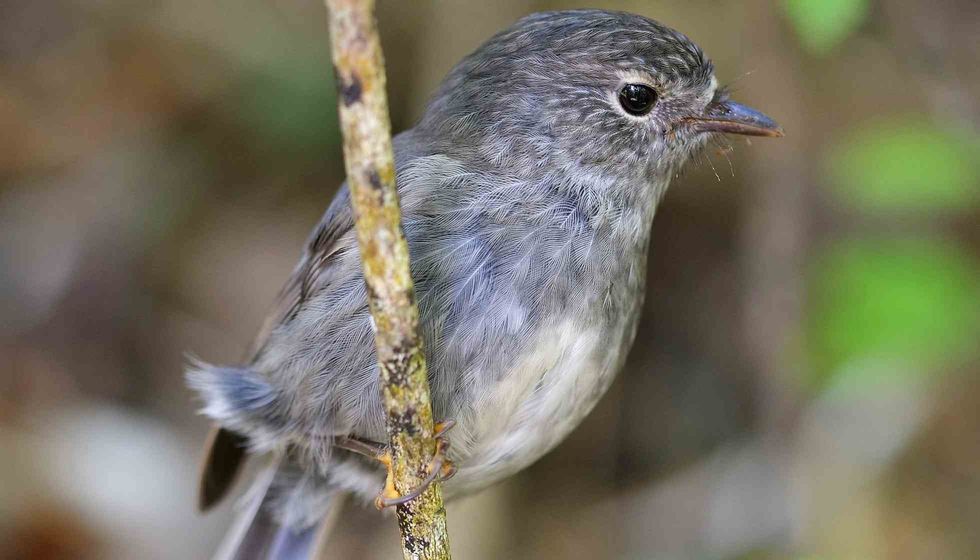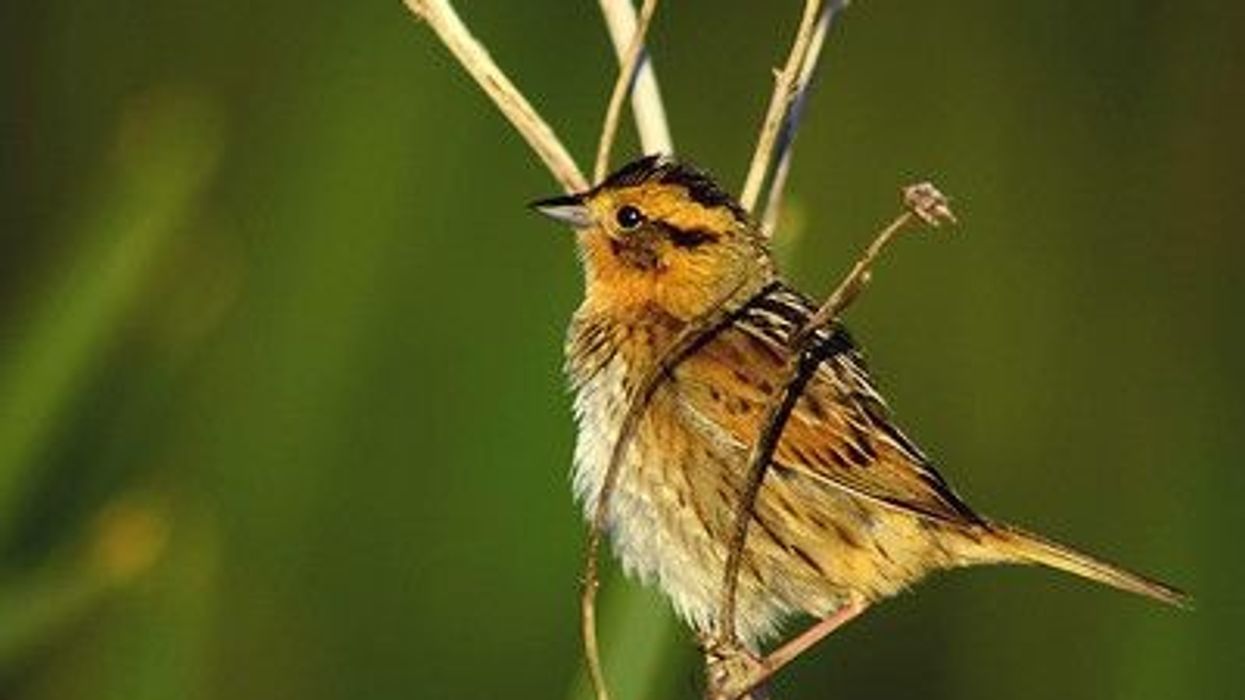The North Island robin (Petroica longipes) or toutouwai is a species of New Zealand robin. It is one of New Zealand's endemic species, being found mainly in Beech and native forest areas. These dark gray birds prefer a mild, subtropical habitat. They are non-migratory, meaning they spend their whole lives nesting and breeding around the Central North Island region.
It is one of three New Zealand robin species, the other two being the South Island robin and Stewart Island robin. However, the latter two are subspecies of each other, with the North Island robin being a completely different species.
They can be seen perching on tree branches, foraging for prey among the forest floors. The male robin is a prolific singer, its call being audible all year round.
To learn more about these melodious birds, read on! You can also find more fly-tastic facts on our European robin and rufous-backed robin pages.
North Island Robin Interesting Facts
What type of animal is a North Island robin?
The North Island robin (Petroica longipes) is a species of the New Zealand robin, and is endemic to New Zealand.
What class of animal does a North Island robin belong to?
The North Island robin (Petroica longipes) belongs to the class of Aves.
How many North Island robins are there in the world?
The exact population of the North Island robin (Petroica longipes) is unknown, however since their status is currently Least Concern, we can assume that they are abundantly found in the wild, and they are plenty in number.
Where does a North Island robin live?
The North Island robin (Petroica longipes) is a type of New Zealand robin bird, and is found exclusively in the central North Island area of Te Ika-a-Māui, New Zealand.
It is mostly found in native beech wood and humid native and exotic forests, from Taraniki through to the Bay of Plenty, and is also found around Little Barrier and Kapiti Islands.
Flocks have also been introduced in Karori Sanctuary and Bushy park reserve, in order to keep a check on their population and protect them from threats such as predation by larger rodents and wildcats.
What is a North Island robin's habitat?
The North Island robin bird can be found in both native and exotic forests and Scrublands. They prefer making their home in humid, moist areas, with open ground under a forest canopy. The Central North Island has a warm, subtropical climate, and mild temperament around the year, which is where these birds can be found.
Who do North Island robin live with?
These birds can be found distributed around the forests in Little Barrier and Kapiti Islands, often being found in scattered flocks or in pairs.
How long does a North Island robin live?
These birds have been known to live for up to 14 years of age.
How do they reproduce?
The breeding season for the North Island robin (Petroica longipes) bird occurs during September and March. Males set out to attract females by bursting into song, and they pair up in order to build their nests and mate.
The female then builds the nest, usually against a tree trunk or in a trunk fork, while the male brings her food. After the mating process, the female will then lay around two to three eggs, which she will incubate for 18-20 days, until they hatch.
The brood is taken care of until they are three weeks old, after which they leave the nest. Chicks become mature enough to mate when they reach 12 months of age.
What is their conservation status?
Their current conservation status is Least Concern, according to the IUCN Red List.
North Island Robin Fun Facts
What do North Island robin look like?
The New Zealand North Island robin (Petroica longipes) species have plumage with a range from light to dark gray, with their underparts being more pale than the rest of their body. They have light streaking on the upper part of their bodies. The sexes look slightly different, with mature males being slightly larger and darker than their female counterparts.
How cute are they?
These small dark gray birds are very cute, with their round fluffy appearance.
How do they communicate?
Males sing more than females, calling in full song all year round, which is more prominent during the breeding season. Both males and females can be heard singing in the off season, with a single tone call and another call lasting three to four seconds among their various vocalizations.
They tend to call out in loud, rapid notes when they sense any threat.
How big is a North Island robin?
The North Island robin (Petroica longipes) has an average length of 7 in (17.7 cm), from beak to tail.
How fast can a North Island robin fly?
The exact speed of this species is unknown. However, we do know that the American robin can fly at the speed of 30 mph (48.2 kph), so the North Island robin bird ought to fly at a similar pace.
How much does a North Island robin weigh?
The North Island robin (Petroica longipes) bird weighs 1.2 oz (34 g) at an average.
What are the male and female names of the species?
There are no distinctive names among the sexes of the gray North Island robin, males simply being called as cocks and females as hens.
What would you call a baby North Island robin?
Baby New Zealand North Island robins are called as chicks, fledglings or hatchlings.
What do they eat?
North Island robins are active terrestrial foragers, perching on low branches to spot prey. They will then swoop down to the ground, searching for invertebrates such as snails, cicadas, worms and spiders among the shrubs and leaf litter.
They will occasionally also feed on fruit. These birds are known food hoarders, storing away their prey for later consumption in small crevices or tree hollows.
Are they dangerous?
These gray birds are quite territorial, attacking any intruders. They attempt to intimidate their enemies with wing and tail flicking. However, they pose no threat towards humans.
Would they make a good pet?
These birds are not kept as pets, only being found in the wild. Since they are accustomed to their habitat of beech wood and native forest, it is difficult to recreate similar conditions in captivity, which can cause them to become unhappy.
It is better to observe this bird in the wild and let them live with their own species.
Did you know...
The New Zealand robin (toutouwai) has three types, these being the North Island robin (Petroica longipes), South Island robin and the Stewart Island robin, the latter two being subspecies. The North and South Islands robins are two completely different species.
Males tend to sing very loudly during the mating season, often bursting into full song in order to try and attract females.
These birds keep caches of food to eat during later seasons, hiding prey in the crevices and hollow tree trunks. This food is consumed during the late summer and early autumn, when conditions are dry and food is not naturally available as easily.
Females tend to do the nest building and chick rearing, with the males bringing her food in two to three hour intervals.
The South Island robin tends to have a more pale breast than the North Island variety, which makes it easier to tell them apart.
Despite its small size, this bird is a known predator, often catching large prey and dividing it up to eat later.
Are North Island robins endangered?
No, this New Zealand robin is not particularly threatened, being considered as Least Concern. However, this robin's population is under threat by introduced predators, mostly being wildcats, stoats, rats and possums. As these animals often hunt at night, they target female nesting robins, which is a big cause of the decline of the breeding population.
Do North Island robin migrate?
No, North Island robins are residential birds and do not migrate. The climate in New Zealand is mild and agreeable all year round, which makes it unnecessary for the toutouwai robins to fly elsewhere for the winter. Both North and South Islands robins are endemic to New Zealand, and cannot be found anywhere else.
Here at Kidadl, we have carefully created lots of interesting family-friendly animal facts for everyone to discover! For more relatable content, check out these bowerbird facts and umbrellabird facts for kids.
You can even occupy yourself at home by coloring in one of our free printable North Island robin coloring pages.










